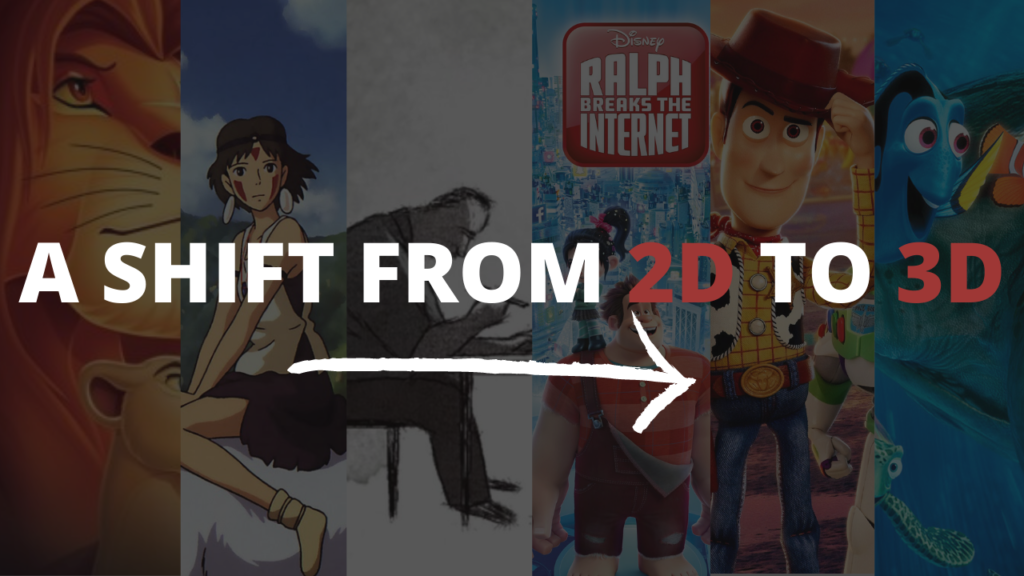
Today we see the rising relevance of 3D by the second. Huge corporations like Disney started shifting to 3D a long time ago.
This makes us wonder, is 2D animation dead? Why invest in making assets that can not be reused the way 3D can? Why go against the popular style? Especially if you’re under a strict budget and NEED your project to work?
In this post, we will explore the world of 2D and talk about whether or not it is still relevant.

2D animation history
If we look at 2D vs 3D art, we find that they have been here since, well, forever. Ever since the dawn of time, humans created art on 2D surfaces such as walls, or on stones to draw things and express themselves and their surroundings, this has not changed much, has it?
You find people still use this method, whether they are children drawing their little houses and “mom” and “dad”, or even the greatest artists of our time such as John Sargeant, Andrew Loomis, Zdzisław Beksiński, and so many others. Or if we want to be recent, we have Lois Van Baarle, Sara Tepes, Stanley Lau and so, so, many more.
3D as an art form, wasn’t so different, you can find your mesolithic and neolithic sculptures or the wonders of Michelangelo and now we even have 3D printers, which by the way that is so cool I will never get over how cool 3D printers, like are you kidding me I can print a THING?!!

The point is, these two mediums have been here since forever, but the way they were used was somewhat devoid of any commercial or financial benefit.
Yes, sure modern artists made a living out of their creations and it helped them not only sustain themselves but gain distinguished social status. Davinci, although many other things, was a painter who was commissioned to paint, and Michelangelo was no different. And many more did the same than I can count on my fingers or in this article.
In fact we even see this way of commodifying art on a smaller scale happening today. You like your favorite artists’ art and want them to paint you, you’re one DM away from that. Can you imagine Davinci being commissioned via Instagram DMs by someone who wants him to draw the client’s OC? I don’t know about you but that is HILARIOUS to me.

Is 2D animation dead now?
The difference today is how art’s commodification has become practiced on a much wider scale than ever before. Thanks to the television and internet, and honestly, technology in general, the usage of art has become present in almost everything.
We find 2D and even 3D animations, for children and adults, advertising and marketing, paintings, drawings commissioned for all kinds of things, from something for professional purposes such as concept art, to personal art for people who want their OCs to come to life, or even video games. Prints, stickers, figurines of your favorite character from that one anime in a cool pose or even a 3D printed special item from your favorite game to go as decoration in your shelves and collections, you name it, 2D or 3D art, or both, is used in it.
The catch though is, it is all about the bottom line first and foremost, especially when we are talking big scale, big corporations and the like, like Disney, whatever is cost effective is taken first and is more in demand. These corporations need to sustain themselves and sometimes the cheapest option is the best.
Is 2D animation better than 3D?
With that in mind, if we take the process of making 2D animations, versus something like 3D as an example to go by, things start to get sour for 2D.

When created, 3D assets can endlessly be reused, the easiest example here is video games. For example, Capcomp, the creator of the famous Resident Evil series reused many of the assets of Resident evil 2 remake in the remake of Resident Evil 3 and that made the productions of the game a lot faster, although they did neglect to include that Clock Tower, yes I’m salty about it.
We can see the reusability of assets dictate how these projects go. I for one think that Resident Evil 8 was in a village and had many of the same mechanics of Resident Evil 4, because the company is for sure going to remake it.

Or for an animation example, say you have a ball or a table render, are you really going to remake them for a new movie? Of course not, especially when deadlines are tight, use the same model and slap a new texture on it and you’re good to go.
The same can be said about 2D though, Disney has been known for reusing 2D animations with slight changes. But, 3D is arguably the best option when it comes to the efficiency of reusing assets.
2D vs 3D animation
Another point to be made is how animating 3D has become incredibly efficient, thanks to new tech, such as mo-cap (or motion capture). All you have to do is create your model and get all suited up in a funky looking skin tight jumper to have the 3D model mimic your moves and get incredibly accurate animation.
Or more simply, animating your 3D objects in the appropriate 3D software for that by taking image sequences, which is a lot more efficient than studying something for God knows how long and then attempt to recreate the movement by drawing it frame by frame if you ask me.
Although animation has come a long way from being entirely hand-drawn to using technology like vector, CGI and many more things that help make animation a much easier option, 3D remains king in the cost and time efficiency department.

Another thing is the human fascination with the ability of art to mimic life. If you go to an artist or someone who is more into art and show them a hyper realistic drawing versus something that’s a bit more stylized, they tend to express liking the latter more than they do the former.

However, if you go to a layman, just a regular person, they’re probably going to like the hyper realistic drawing rather than the stylized one. Hyper realistic, realistic, or semi realistic are always a lot more likable, this relates to 3D because it’s more realistic than 2D.
Sure, there are many hyper realistic drawings, but can a 2D hyper realistic painting compete with a hyper realistic 3D sculpture for the attention of the mainstream? I don’t think so.
Advantages of 2D animation
Don’t be tricked into thinking this post is here to convince you that 2D is dying, because it isn’t.
Although these can be indicators of why less and less corporations are using 2D to animate their movies, shows and what have you, we don’t think this is going to affect 2D one bit. The reason why we might feel that 2D is dying in relevance is because 3D is a lot more accessible.
Do you ever see those sketchy ads for very extremely weird games made for toddlers who only play them because they’ve just stumbled on them? Those can be created using pre-made free 3D assets.
Or ever wonder how game developers can make very large open world games? They don’t model and render every tree, all they have to do is strategically place the same tree and modify it slightly to seem different.

So, what does this really mean?
This means that you feel a shift towards 3D due to its accessibility, which translates to a huge leap in 3D by the demand for it rising more and more by the day. However this doesn’t mean 2D is completely gone, it just means that 3D is catching up to 2D.
Think about it, entertainment in general, whether shows, movies or even ads all used 2D; think Betty Boop, Cinderella and the seven dwarfs and Leydendecker’s advertisement art, has always used 2D art in everything.
Now we see the use of 3D in those same aspects which made the making of this type of content a lot more abundant and available to more people, but in turn 2D didn’t disappear from those spaces at all, especially since 3D isn’t the only one benefiting from technology here.

Thinking that 2D is dying and fading away from relevance is like thinking that real physical books are now forever gone and that they’re being completely overtaken by PDFs, kindles and what have you. Crazy right?… Exactly!
2D is too much of a huge aspect of human history and human experience for it to be washed away by 3D just like that. When something deeply rooted in human nature is at play, I, for one, don’t ever think it will be replaced. Nothing will take 2D away from humans and at the very least not for a long time.

Conclusion
Certainly, as art, and by extension 2D, is part of human nature it is really hard to get anything that is factual or absolute that will tell you one form or art will cease to exist or not.
Sure, artistic trends that still happen even today are very much a thing but they don’t change the core of 2D and they don’t annihilate it, not for a long time at least. And the relevance of 3D today doesn’t mean the relevance of it forever, you just never truly know about these things especially now that technology is rapidly evolving.
One simple example is how now 2d is a lot more accessible than it was 50 years ago. There could be a complete switch in trends where 2D finally becomes the most cost effective of the two and ends up stealing the show in the end. What’s most important is that 2D was, is and will always be a staple no matter the time or the trend and it is here to stay.































